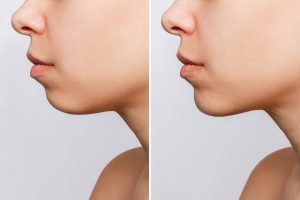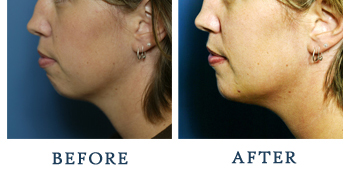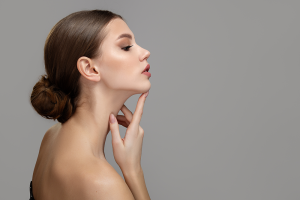Chin augmentation can dramatically improve the appearance of your entire face by correcting a receding chin or a chin that sags from the jawline (chin ptosis). At Cascade Facial Surgery, Dr. Jonathan Grant treats every patient as a unique individual. Your surgical plan is designed specifically to provide you with the result you want within the parameters of sound and safe medical practices.
Dr. Grant’s training and experience as a reconstructive facial surgeon allows him to evaluate your chin and determine the best way to restore facial symmetry. This surgery usually involves the insertion of a chin implant.
Some patients have rhinoplasty (cosmetic nose surgery) along with chin augmentation to create greater facial harmony between the nose and chin.
Who Is a Candidate for Chin Augmentation?
Candidates for chin augmentation are physically fit, have realistic augmentation expectations, and dislike the look of their chin, including issues such as:
A weak, receding chin. A weak chin is also referred to as retrogenia and is characterized by a sloping appearance. A chin implant during your augmentation procedure may be ideal in this case.
Chin ptosis. If your chin sags from the jawline, you may have a condition known as chin ptosis. There are two types of this condition: static, which requires structural correction, and dynamic, where excess tissue tends to change the chin’s appearance when the facial position changes, such as when smiling.
Shallow neck. Chin augmentation in certain individuals can add depth to the area just under the jawline.
Benefits of Chin Augmentation
- Improved Facial Balance and Symmetry: Enhances harmony among facial features, achieving a more balanced and attractive look.
- Enhanced Jawline Definition: Increases definition in the jawline, offering a stronger and more sculpted appearance.
- Correction of Receding Chin: Corrects a receding chin to a more proportional and forward-projecting position, improving overall facial profile.
- Anti-Aging Effects: Helps reduce the appearance of a double chin and sagging skin, providing a more youthful facial contour.
- Increased Self-Confidence: Boosts self-esteem and confidence, positively impacting social and professional interactions.
- Customizable and Reversible Options: Offers a range of surgical and non-surgical procedures tailored to individual needs, with non-surgical options being reversible.
- Minimal Downtime: Non-surgical treatments allow for a quick return to daily activities; surgical options have also evolved to allow for faster recovery.
Types of Chin Augmentation
 Chin augmentation can be achieved through surgical or non-surgical methods, each with its own set of techniques and considerations:
Chin augmentation can be achieved through surgical or non-surgical methods, each with its own set of techniques and considerations:
Chin Implants: This is the most common surgical method for enhancing the chin’s projection and shape. A biocompatible implant, typically made of silicone, is tailored to fit your facial structure. Dr. Grant inserts this implant via a small incision under your chin or inside your mouth.
Sliding Genioplasty: For those requiring more significant changes, sliding genioplasty involves cutting the chin bone and repositioning it to improve its size and projection. This method is preferred for its permanency and the ability to alter bone structure extensively.
Fat Grafting: This involves harvesting fat from another part of your body with liposuction and then injecting these excess fat cells into your chin. This can provide a more natural augmentation.
Injectable Fillers: This method uses injectable dermal fillers to enhance the chin area. Fillers such as hyaluronic acid, calcium hydroxylapatite, or poly-L-lactic acid are injected to increase volume and define the chin contour. The results are temporary, lasting six months to two years, depending on the type of filler used.
Each type of chin augmentation has benefits and potential risks, and the best choice will depend on your aesthetic goals. Hence, patients must have a detailed consultation with Dr. Grant to discuss all available options and what to expect from each.
Chin Augmentation Costs
The price of chin augmentation can vary depending on Dr. Grant’s technique to achieve your desired look. All costs will be discussed during a consultation so that you may make an informed decision. Chin augmentation is not typically covered by insurance because it is an elective cosmetic procedure. Financing is available through CareCredit.
Understanding the Chin Augmentation Procedure
Dr. Grant will examine you during your consultation and discuss what you dislike about your chin. Then, he can devise a surgical plan for you.
You should come to your appointment prepared to discuss you overall health, current medications, and specific areas of concern. It’s ok if you do not know exactly which procedure you need. Dr. Grant will take into account all of your aesthetic concerns and make recommendations for specific procedures, or a combination of treatments, based on your goals.
During the consultation, we use the Canfield Mirror imaging software to help you see different looks on your face as an approximation of how you would like your chin to look.
The surgery is an outpatient procedure that can sometimes be performed using IV anesthetic and sedation, while some patients may require general anesthesia. You will be able to go home on the same day as your surgery.
Incisions for chin augmentations are usually made under the chin in a preexisting skin fold. The implant is then inserted in the proper place, and the incisions are sutured.
Recovering From Chin Augmentation
You can expect to need a week to two weeks off from work after chin augmentation surgery. You will have no diet restrictions, but please avoid sports and exercise for two to three weeks.
After all surgeries, there is some pain and swelling. Some patients also experience some mild bruising. There may also be some numbness in the incision areas and possible (rare) on the lip, which typically resolves within days to a few weeks.
You can take pain medication, and we will give you instructions how to take care of your chin during this time. Sleeping upright or with your head elevated for the first two weeks will help to keep swelling to a minimum.
Note that swelling is the last symptom to resolve. While your chin will look better immediately due to the implant, it will take some time for the last bit of swelling to go down. Dr. Grant will check you intermittently throughout the first year following your surgery. Most of our patients remark that the recovery period is quite easy and well worth the results.
Here is a general timeline of the chin augmentation recovery process:
Immediately following chin augmentation surgery. Right after surgery, and for about two or three days, you may experience swelling and tenderness. The dressing that Dr. Grant applies when your surgery is complete will remain during this time.
The week following surgery. Dr. Grant may recommend you refrain from chewing as much as possible for about one week post-op. You may need to consume a liquid diet or soft foods during this time. Tightness around the chin area is common, but swelling should begin to subside, and normal activities may be resumed a few days later.
Six weeks after surgery. At the six-week mark, most swelling will have subsided, and your results should become more apparent. You should be getting back to regular life at this time, and your swelling will continue to subside until it is completely gone.
You should report any unusual bleeding, swelling, or lingering pain to Dr. Grant. You will receive full recovery and care instructions so that you know what to expect.

Chin Augmentation FAQ’s
What is chin augmentation?
 Chin augmentation is a procedure that addresses receding and weak chins. It essentially increases the chin’s projection, as well as the height, if necessary. While implants are common in this procedure, not all chin augmentation procedures require them.
Chin augmentation is a procedure that addresses receding and weak chins. It essentially increases the chin’s projection, as well as the height, if necessary. While implants are common in this procedure, not all chin augmentation procedures require them.
What does chin augmentation improve?
Chin augmentation improves the appearance of chins that do not project naturally on their own. When viewing your side profile, the forehead, nose, and chin are the three points that project the most. If you notice that your profile appears unbalanced because of a receding or sagging chin area, chin augmentation may be right for you.
Are chin augmentation results obvious?
When you receive a chin augmentation from Dr. Grant, your results appear natural, whether an implant is used or not. Chin augmentation should improve facial harmony. Friends and family may notice a difference in your face in that it appears more balanced, but likely will not be able to tie that change specifically to chin augmentation.
Can chin augmentation be combined with other treatments?
Chin augmentation procedures are usually completed on their own, but it is common to combine this procedure with others. Patients may opt for neck liposuction, rhinoplasty, and additional procedures that improve facial balance along with chin augmentation.
Can chin augmentation help with neck sagging?
When the projection of the chin is corrected during augmentation, the neck’s appearance can change as well. Many patients observe a more lean and youthful profile of the neck when the chin’s projection increases since the skin of the neck is pulled more taught. It should be noted that while chin augmentation can contribute to an improved neck appearance, a more dramatic change can be achieved by choosing a procedure that specifically targets the neck.
How long do chin augmentation results last?
 Results from surgical chin augmentation, such as chin implants or sliding genioplasty, are generally permanent. While the initial healing might take a few weeks, the outcomes are designed to last a lifetime unless the patient experiences any physical trauma or decides to have the implant removed or modified. Fat transfer can also last for many years, although the effects of aging may lead to some fat being reabsorbed.
Results from surgical chin augmentation, such as chin implants or sliding genioplasty, are generally permanent. While the initial healing might take a few weeks, the outcomes are designed to last a lifetime unless the patient experiences any physical trauma or decides to have the implant removed or modified. Fat transfer can also last for many years, although the effects of aging may lead to some fat being reabsorbed.
Am I too young or too old to have chin augmentation?
Chin augmentation can be performed on adults of any age, as long as they are in good health, have realistic expectations, and have fully matured facial bones, which typically occurs by the late teens to early twenties. There is no upper age limit for chin augmentation; however, non-surgical options might be particularly appealing to older patients seeking less invasive treatments with minimal recovery time.
Learn More
If you are interested in chin augmentation in the Western Washington area, contact us to find out if you’re a good candidate for the procedure.
Contact Us Today!






